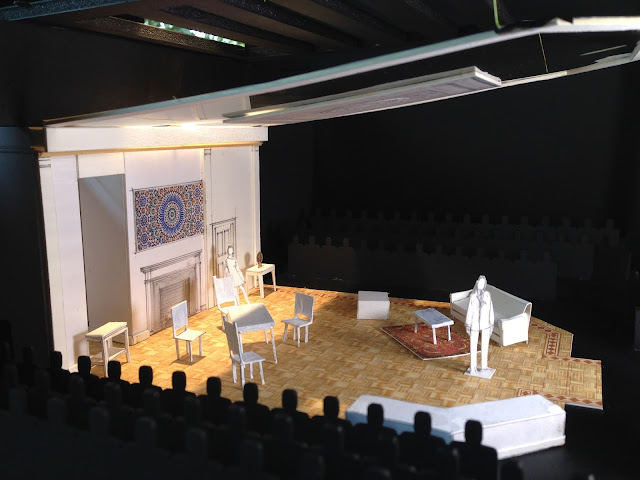 |
| Alhambra art inspiration |
She
and director Shishir Kurup have known each other since the early 1990s. Since then they’ve been frequent collaborators, usually
in Los Angeles through shared experiences with Cornerstone Theater
Company.
She’s delighted to be at PlayMakers noting the theatre’s “wonderful”
craftspeople who embrace the technical challenges of engineering and
constructing every detail of the setting, as well as the impact of our strong
graduate programs and the benefits of those students on the quality of work.
She’s also impressed with PlayMakers’ commitment to community dialogue and
efforts to create a space for meaningful conversation.
Nephelie
describes her process as starting with text and action. She reads and re-reads
the play, “un-structuring” the playwright’s work to find underlying stepping
stones, clues and instigators for the actions that grow from the words. “My job
as a designer is to imagine and create a physical, visual, aesthetic world in
which the poetry and action seem perfectly surprising and inevitable. I start
by building breakdowns of both the broad strokes and small details within each
scene, each page. I digest the play, internalize and understand it to the point
where I can imagine the space as a dynamic container for its action and poetry.”
 |
| Nephelie's model for PlayMakers' production of Disgraced |
The
setting for Disgraced is the interior of a Manhattan apartment over the course
of several months. There are very specific actions in the play, and moments of discovery, in which what
was meant to be private is witnessed by another. Some of these are dark, ugly moments
of human behavior. And therefore the geography of the set must be very
particular: some actions must be hidden, while others must be revealed. Characters must see or hear, or not see or
hear specific, significant moments of interaction between other
characters.
Another
challenge is that the play was originally envisioned to be presented in a
proscenium stage, with built-in mechanisms to control what is revealed and what
is hidden from the audience. The PlayMakers stage is deep thrust. Nephelie
describes the difference for us.
“The
spatial dynamic of the Paul Greene Theatre brings the audience in close to the action, much like
an ancient Greek amphitheatre (a space for dance, direct address and discourse)
than like the Renaissance proscenium (a space for magic and spectacle) where
the audience and performer operate facing out towards the other.”
 |
| Another view of Nephelie's model for the Paul Green Theatre |
But
ultimately, says Nephelie, the venue shares much with the principles of the
ancient amphitheatre, where attendance to see a new play was an act of citizenship
as much as an opportunity for entertainment. With this in mind, the main action takes
place in the central space that is the physical, visual, vocal focus of the
theatre. This is where the action and characters reveal themselves and serves
as the focal point for the audience, keeping attention on the key questions of the
play.
“The
hope is that [our production] will entertain (it has so much humor!) while inviting
audiences to see themselves, and those we imagine as ‘others,’ in a fresh way.
So we begin to talk about the ways in which we Americans are all interdependent
and can begin to see and be seen, to be known to ourselves and to each other. Being
a part of that conversation made me want to be a part of this production.”
Join
us as Disgraced brings the conversation center stage beginning September 16th.
Click here or call our Box Office
at 919-962-7529 for tickets or more information.
